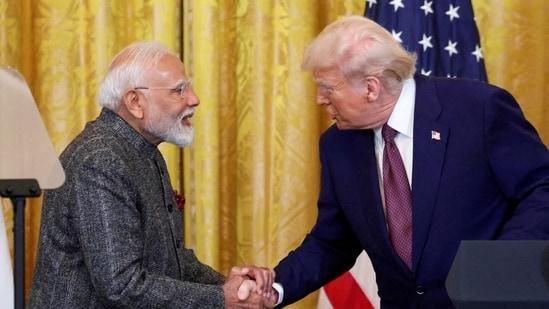Trump Declares 25% Tariff on India, Citing Trade and Russia Concerns
In a move set to reshape bilateral trade between the world’s largest democracies, US President Donald Trump has announced a 25% tariff on Indian imports starting August 1. The decision comes with an added penalty, pointing to India’s ongoing defense and energy ties with Russia during the Ukraine conflict.
“India will therefore be paying a tariff of 25%, plus a penalty for the above, starting on August first,” Trump said in a post shared Wednesday. “Thank you for your attention to this matter. MAGA!”
The announcement — though not entirely unexpected — lands at a sensitive time when India and the US have been engaged in extensive trade negotiations. Many anticipated a tariff in the 20–25% range, but the added penalty appears to have taken New Delhi by surprise.
Timeline of Events
- Early July: Commerce Minister Piyush Goyal reiterated that India won’t push a trade agreement under external pressure or deadlines.
- Mid July: NATO and US lawmakers started increasing warnings, signaling tariffs on countries trading with Russia.
- July 9: The US extended a tariff moratorium by 22 days, providing countries one last window for negotiation.
- July 24: Trump hinted at a 20–25% tariff rate aboard Air Force One, stating India “has charged more tariffs than almost any other country.”
- July 26: Trump officially confirmed a 25% tariff plus an added penalty for India.
Trump’s Breakdown: Trade Frustrations and Russian Oil
Much of Trump’s frustration with India centers around what he describes as “strenuous and obnoxious non-monetary trade barriers.” In a characteristically blunt post, the US President claimed that India has some of the highest tariffs in the world and that the US has done “relatively little business” with India for this reason.
“They have the most strenuous and obnoxious non-monetary Trade Barriers of any Country,” Trump wrote.
That’s not all. A significant part of Trump’s move relates to India’s continued ties with Russia, particularly in the defense and energy sectors. According to Trump, India remains one of the biggest buyers of Russian oil and military equipment — something the West has been urging countries to avoid due to the ongoing Ukraine war.
“They have always bought a vast majority of their military equipment from Russia, and are Russia’s largest buyer of ENERGY, along with China,” Trump said.
Official Statements and Policy Echoes
The announcement isn’t happening in isolation. It closely mirrors statements made earlier by Senator Lindsey Graham and NATO Secretary General Mark Rutte. Last week, Senator Graham warned that Trump would “put a 100% tariff on all those countries” continuing to fund Putin’s war machine through oil purchases — explicitly calling out India, China, and Brazil.
Graham estimated that roughly 80% of cheap Russian oil is being funneled to these three nations alone. He argued this drives resources to continue Moscow’s military operations in Ukraine.
India’s Response — Measured but Firm
India, for its part, hasn’t directly responded to the 25% tariff as of press time. But earlier in the month, Commerce Minister Piyush Goyal had noted India’s position clearly. “India does not enter into any trade agreement based on deadlines,” Goyal said. “It has to be properly concluded and in the national interest.”
The government may maintain a public stance of waiting and watching — but behind the scenes, it’s likely that diplomats and trade officials are scrambling to re-assess the contours of bilateral talks.
Community and Business Reaction
There’s frustration — and a bit of fatigue — among Indian exporters, particularly those in the tech, pharmaceutical, and textile sectors. A 25% tariff could be deeply painful, especially for medium-sized businesses that rely on predictable margins to operate in the American market.
Here’s what some small business owners are saying:
- “This is disappointing. We’ve spent the last six months preparing to scale up for the US market,” said Rina Patel, textile exporter from Gujarat. “Now we’re not sure we’ll survive the pricing impact.”
- “What makes it harder is the uncertainty. We get it — geopolitics is complex — but this is suddenly affecting our bottom line,” noted Manoj Iyer, a software developer with US-based clients.
Larger corporations have tools and flexibility to mitigate such fallout. But the more vulnerable tier — smaller exporters and manufacturers — will bear the brunt more sharply.
Trade — A Complicated Partnership
Despite frictions, India and the US have long enjoyed a complex, interwoven trade relationship. Trade volume between both countries topped USD 191 billion in 2022-23, making the US India’s largest trading partner.
Yet, the tariff issue has remained a thorn. Trump previously removed India from the Generalized System of Preferences (GSP) in 2019, citing similar concerns around market access and tariffs.
India has consistently pushed back, arguing that its tariffs reflect the needs of an emerging economy. And though the two sides were inching closer to a long-term trade pact, it now seems increasingly uncertain whether that will happen soon — or at all.
What’s Next?
With the August 1 deadline looming, India will have to decide whether to concede to some of Washington’s terms or brace for a prolonged trade standoff. The situation is made even more complex by US election dynamics, as Trump’s volatile trade maneuvers play well to his political base.
New Delhi has three likely paths:
- Push back diplomatically while working behind the scenes to de-escalate.
- Conclude a limited trade agreement that offers Trump a ‘win’, while protecting domestic priorities.
- Hold firm — and prepare for retaliation or alternative markets.
Each of these options comes with benefits — and a cost. As pressure builds, India is likely to walk a tightrope between standing its ground and preserving a strategic partnership with the United States.
For now, all eyes are on August 1.

